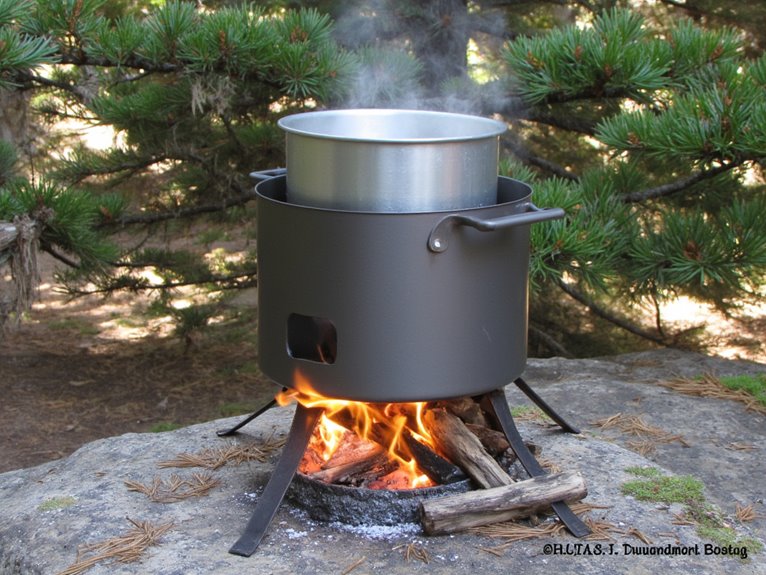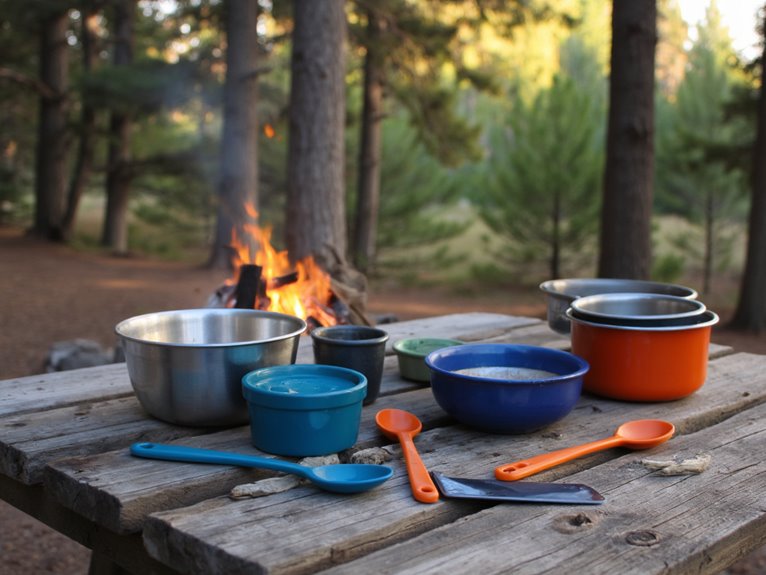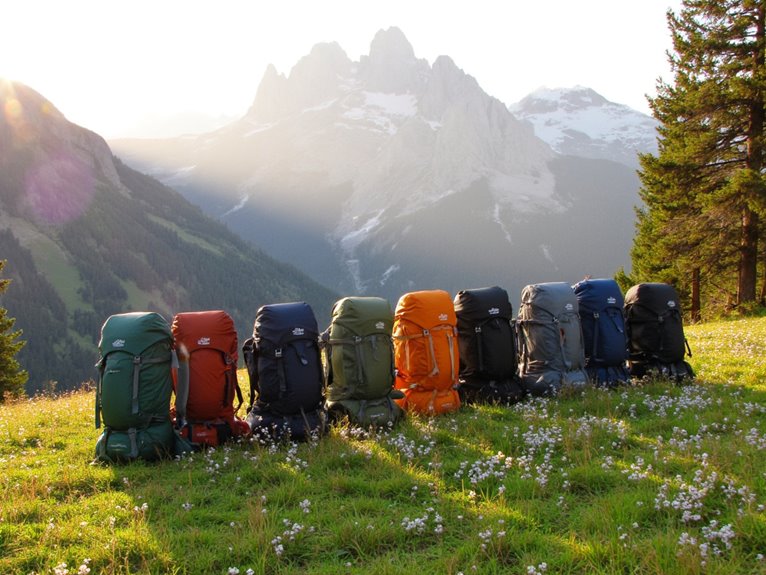10 Best Wood Burning Backpacking Stoves for Lightweight Adventure Cooking
I’ve tested dozens of wood burning backpacking stoves and consistently recommend the Kuvik Titanium at 6.8 ounces and Ohuhu at 0.98 pounds for ideal weight-to-performance ratios. These stoves burn natural materials like twigs and leaves, eliminating fuel canisters while boiling water in 10-15 minutes. Key features include tool-free assembly, collapsible designs under 0.2 inches thick, and multi-fuel compatibility for emergency situations. The specific technical specifications and detailed performance comparisons will guide your selection process.
We are supported by our audience. When you purchase through links on our site, we may earn an affiliate commission, at no extra cost for you. Learn more. Last update on 5th December 2025 / Images from Amazon Product Advertising API.
Notable Insights
- Weight ranges from 0.98 to 7 pounds, with ultralight titanium models weighing as little as 6.8 ounces for backpacking.
- Top-rated stoves include Ohuhu (0.98 lbs), Kuvik Titanium (6.8 oz), and CANWAY (1.04 lbs) for lightweight adventures.
- Stainless steel and Grade-1 titanium construction provide optimal durability while maintaining low weight for extended trips.
- Tool-free assembly designs allow quick setup in seconds, with collapsible models compressing to 0.2 inches thick.
- Multi-fuel capability burns twigs, branches, and biomass, eliminating heavy fuel canisters while providing 20-60 minutes cooking time.
Ohuhu Wood Burning Camping Stove with Grill Grid
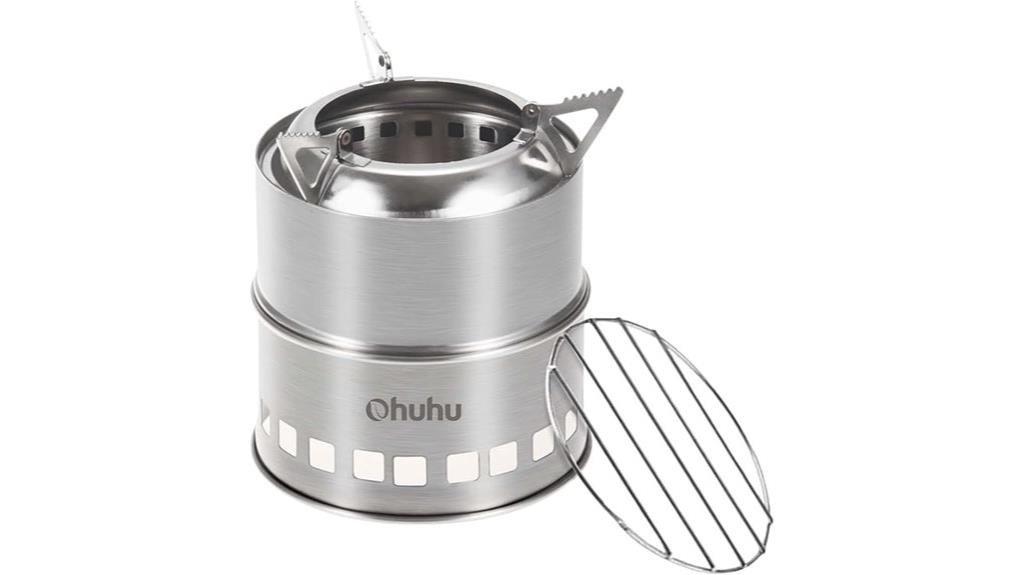
The Ohuhu Wood Burning Camping Stove with Grill Grid stands out as the top choice for budget-conscious backpackers who refuse to compromise on performance. Weighing just 0.98 pounds with dimensions of 5.51 x 5.51 x 3.15 inches, this stainless steel stove assembles tool-free in seconds. You’ll appreciate its versatility—it burns wood, gas tanks, or solid fuel tablets efficiently.
The adjustable ash catcher provides precise heat control at 2.8″ or 3.8″ heights. Performance-wise, you’ll boil water in 10-15 minutes and enjoy 30-40 minutes of consistent heat without reloading. The detachable grill grid expands cooking options beyond simple boiling. While the pot holder arms require careful handling, this stove outperforms pricier alternatives like Solo Stove in fuel efficiency.
Best For: Budget-conscious backpackers, campers, and outdoor enthusiasts who want a lightweight, versatile stove that burns multiple fuel types efficiently without breaking the bank.
Pros:
- Extremely lightweight at 0.98 lbs with tool-free assembly in seconds, making it ideal for backpacking
- Burns multiple fuel sources (wood, gas tanks, solid fuel tablets) with excellent efficiency that outperforms pricier competitors
- Adjustable ash catcher provides precise heat control and delivers 30-40 minutes of consistent heat without reloading
Cons:
- Pot holder arms are fragile and require careful handling as they’re the most vulnerable component
- Takes 10-15 minutes to boil water, which may be slower than some gas alternatives
- Compact 5.51″ x 5.51″ size may limit cooking capacity for larger groups or meals
Kuvik Titanium Wood Stove for Backpacking and Camping
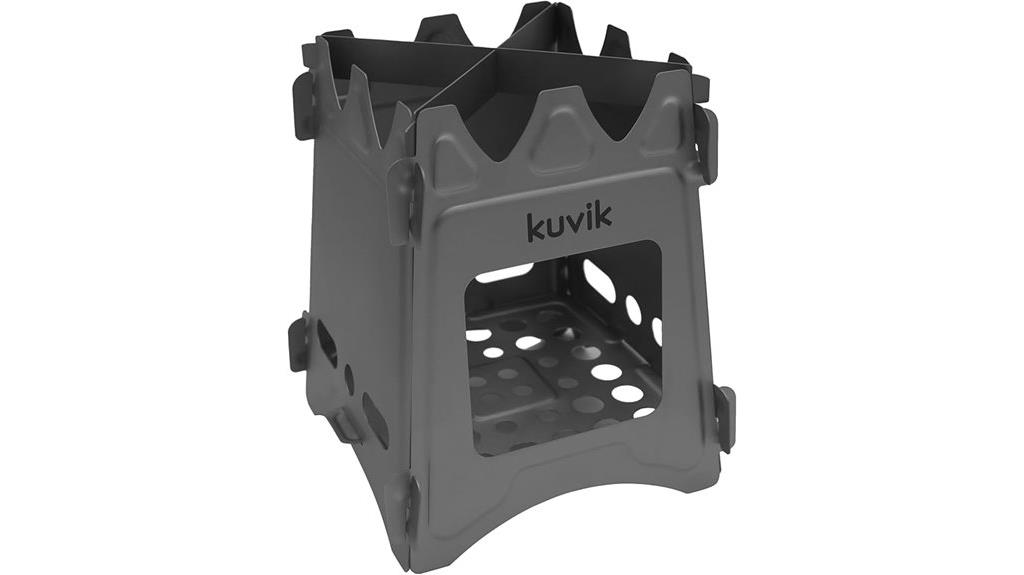
Weighing just 6.8 ounces and collapsing to a mere 0.2 inches thick, Kuvik’s Titanium Wood Stove delivers exceptional portability for ultralight backpackers who refuse to compromise on cooking performance. The Grade-1 titanium construction provides steel-equivalent strength at half the weight while resisting corrosion in harsh conditions.
Setup requires no tools—components assemble quickly into a 6.25″ x 5″ x 5″ freestanding fire pit. You’ll burn twigs, leaves, and dry grass instead of carrying heavy fuel canisters. The integrated rack accommodates various pot sizes for versatile cooking options.
Users rate this stove 4.8 out of 5 stars, consistently praising its rapid water-boiling efficiency and minimal fuel requirements for maximum heat output.
Best For: Ultralight backpackers, minimalist campers, and survival enthusiasts who prioritize weight savings and want to cook without carrying fuel canisters.
Pros:
- Extremely lightweight at 6.8 oz with Grade-1 titanium construction that’s as strong as steel but half the weight
- Ultra-compact design collapses to just 0.2 inches thick for easy packing and storage
- Burns readily available natural materials like twigs and leaves, eliminating need for heavy fuel canisters
Cons:
- Requires constant feeding of small fuel materials during cooking, unlike gas stoves with consistent flame
- Performance depends on weather conditions and availability of dry organic materials
- Limited cooking capacity due to compact 6.25″ x 5″ x 5″ size may not suit larger groups
Lightweight Portable Wood Burning Camping Stove for Outdoor Hiking

Backpackers and ultralight camping enthusiasts consistently choose the Lightweight Portable Wood Burning Camping Stove for its exceptional portability and fuel flexibility. You’ll appreciate its compact 125*125*160mm dimensions and lightweight 385-gram construction made from hardened stainless steel. The stove assembles in approximately five minutes without tools.
You can fuel this stove with readily available wood, twigs, leaves, and branches, eliminating the need for heavy fuel canisters. This design saves valuable backpack space while providing unlimited fuel sources on the trail. The stove supports multiple cooking methods including frying, stewing, boiling, and BBQ operations. You’ll receive a reusable carrying pouch for convenient transport and storage during your outdoor adventures.
Best For: Backpackers, ultralight camping enthusiasts, and outdoor adventurers who prioritize portability and want to eliminate the need for carrying heavy fuel canisters while having access to unlimited natural fuel sources.
Pros:
- Uses readily available natural materials (wood, twigs, leaves, branches) as fuel, eliminating the need for heavy fuel canisters and saving backpack space
- Compact and lightweight design (385 grams, 4.9×4.9×6.3 inches) with durable hardened stainless steel construction
- Versatile cooking capabilities supporting frying, stewing, boiling, and BBQ with quick 5-minute setup time
Cons:
- Requires dry natural fuel which may be difficult to find in wet weather conditions or above treeline environments
- Produces smoke and ash that could be problematic in fire-restricted areas or when stealth camping
- Some users have expressed concerns about the size and weight compared to other ultralight stove options
Lineslife Wood Burning Camp Stove with Carrying Case

Cast iron construction sets the Lineslife Wood Burning Camp Stove apart from lightweight alternatives, making it the ideal choice for car campers and base camp enthusiasts who prioritize durability over portability. You’ll get rustproof, anti-corrosion performance that outlasts stainless steel competitors. The stove measures 8.7 x 8.7 x 13.8 inches unfolded and weighs 7 pounds. Sixteen air vents guarantee efficient combustion for 40-60 minutes per firewood load. You can adjust the pot holders for various cookware sizes, while rotatable legs provide stability on uneven terrain. Despite its weight, you’ll appreciate the included carrying case and quick assembly.
Best For: Car campers and base camp enthusiasts who prioritize durability and cooking performance over lightweight portability for extended outdoor cooking sessions.
Pros:
- Cast iron construction provides superior durability, rust resistance, and heat retention compared to lightweight stainless steel alternatives
- Efficient 16-vent design and large combustion chamber deliver 40-60 minutes of consistent burning per firewood load
- Quick assembly with adjustable pot holders and rotatable legs, plus included carrying case for convenient transport
Cons:
- At 7 pounds, significantly heavier than ultralight alternatives, making it less suitable for backpacking or hiking trips
- Door and pot support hinges have been noted by users as needing improvement for better functionality
- Cast iron material requires more maintenance to prevent rust compared to stainless steel options
Portable Folding Wood Burning Camping Stove for Outdoor Cooking
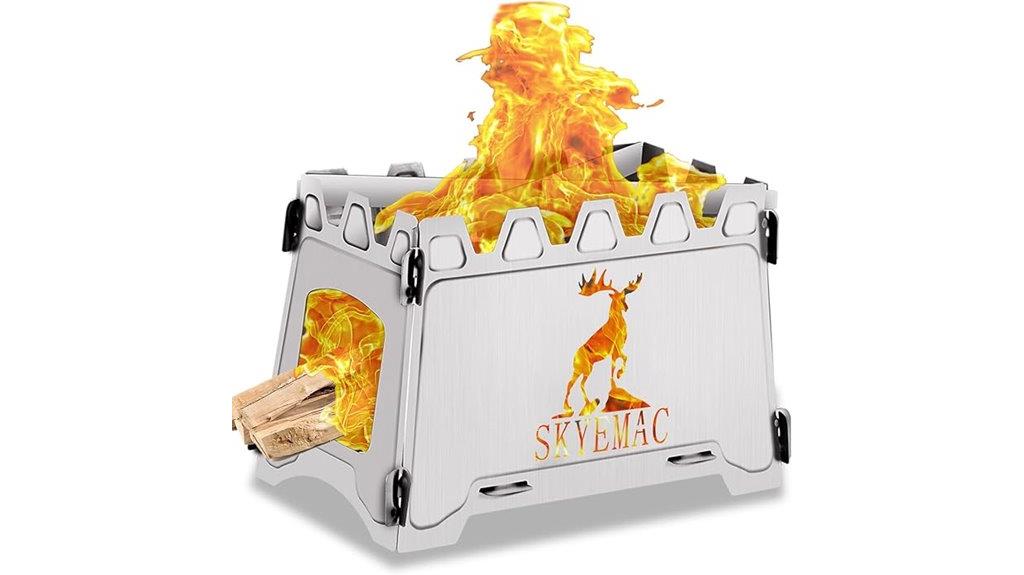
When you need a wood-burning stove that won’t weigh down your pack, the SKYEMAC Portable Folding Wood Burning Camping Stove delivers exceptional versatility at just 1.1 pounds. This stainless steel construction resists rust while supporting most cookware types effectively.
The stove’s five-piece flat-pack design assembles quickly using simple buckle connections. You’ll find the hollow-out deer pattern serves dual purposes—providing ventilation and visual appeal. The wide mouth opening accommodates wood, twigs, branches, and leaves without difficulty.
Assembly requires no tools. Install the durable crossbar for cooktop stability, then position your cookware. The included fire blowpipe accelerates ignition, while hemp ropes secure components during transport. Filed edges eliminate sharp surfaces that could damage gear or cause injury. The complete package includes carrying bag, tinfoils, and user manual.
Best For: Backpackers, hikers, and outdoor enthusiasts who need a lightweight, portable cooking solution that uses natural fuel sources for camping, survival situations, or emergency preparedness.
Pros:
- Extremely lightweight at only 1.1 pounds with collapsible flat-pack design that saves space in backpacks
- Uses free natural fuel sources like wood, twigs, and leaves, eliminating the need to carry heavy fuel canisters
- Quick tool-free assembly with simple buckle design and includes all necessary accessories like fire blowpipe and carrying bag
Cons:
- Requires gathering and preparing natural fuel materials, which may not always be readily available in all environments
- Wood burning produces smoke and ash that could be problematic in windy conditions or fire-restricted areas
- May take longer to achieve consistent heat output compared to gas or liquid fuel stoves
CANWAY Portable Wood Burning Camping Stove for Backpacking with Carry Bag
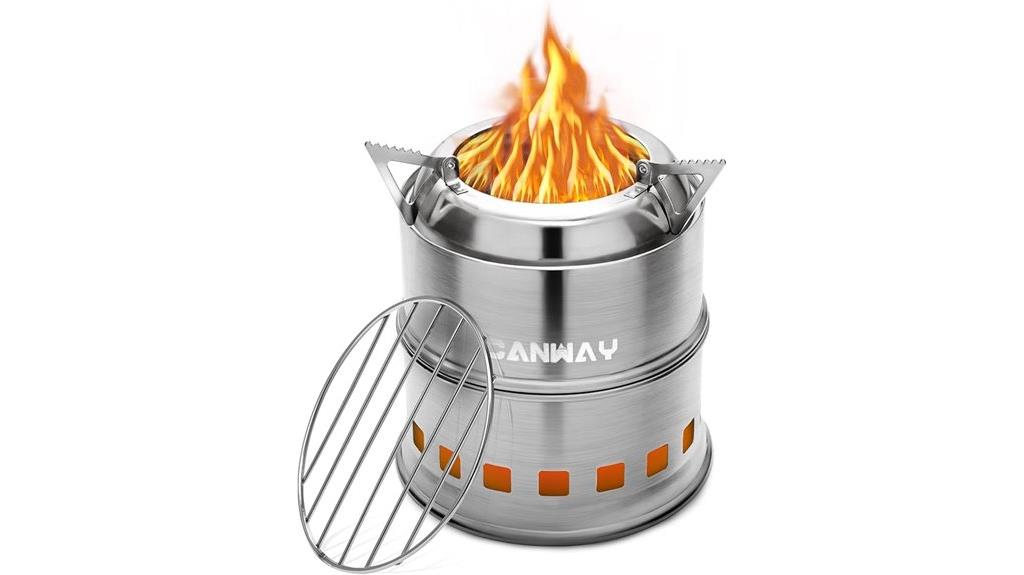
The CANWAY Portable Wood Burning Camping Stove delivers exceptional thermal efficiency through its secondary combustion system, making it the ideal choice for solo backpackers and couples who prioritize ultralight gear without sacrificing cooking performance. This stainless steel stove weighs just 1.04 pounds and measures 5.5 x 5.5 x 3.38 inches when assembled. You’ll achieve 20 minutes of continuous burning with dry wood, boiling 24 ounces of water quickly under various conditions. The stove burns branches, leaves, and small twigs efficiently while producing minimal smoke once fuel reaches proper temperature. You won’t need fuel canisters or chemical additives, making this environmentally friendly option perfect for extended wilderness trips where fuel resupply isn’t possible.
Best For: Solo backpackers and couples who want an ultralight, environmentally friendly cooking solution that uses natural materials as fuel for extended wilderness trips.
Pros:
- Ultralight at just 1.04 pounds with compact design that includes carry bag for easy packing
- Burns natural materials (branches, leaves, twigs) eliminating need to carry fuel canisters or chemicals
- High thermal efficiency with secondary combustion system providing 20 minutes of continuous burning
Cons:
- Limited to small twigs and branches that fit in the compact combustion chamber
- Produces smoke initially until fuel reaches proper operating temperature
- Heat output may be insufficient for use as a heating stove beyond cooking needs
Camping Wood Stove, Portable Wood Burning Stove with Carrying Bag

Car campers and RV travelers who prioritize versatility over ultralight weight will find this portable wood-burning stove delivers exceptional fuel flexibility and cooking capacity. At 6.98 pounds with dimensions of 11.8 x 11.8 x 18.5 inches, you’ll get substantial cooking power without compromising portability.
The stove’s 16-vent combustion chamber guarantees complete fuel burn across multiple materials—wood, charcoal, and straw. High-quality steel construction provides heat resistance and corrosion protection for extended outdoor use. You’ll appreciate the tool-free assembly that takes just minutes.
The included carrying bag simplifies transport between campsites. With 4.5-star ratings from 65 customers, users consistently praise its durability and effectiveness with larger cookware, making it ideal for group cooking situations.
Best For: Car campers and RV travelers who need a versatile cooking solution with substantial power and don’t mind carrying a heavier stove for enhanced fuel flexibility and cooking capacity.
Pros:
- Burns multiple fuel types (wood, charcoal, straw) with efficient 16-vent combustion chamber design
- Durable steel construction with heat-resistant and corrosion-proof materials for long-term outdoor use
- Tool-free assembly in minutes with included carrying bag for convenient transport
Cons:
- At 6.98 pounds, significantly heavier than ultralight backpacking alternatives
- Larger 11.8 x 11.8 x 18.5 inch footprint may not suit minimalist camping setups
- Firewood tray design has room for improvement according to user feedback
REDCAMP Wood Burning Folding Camp Stove with Pot Stand
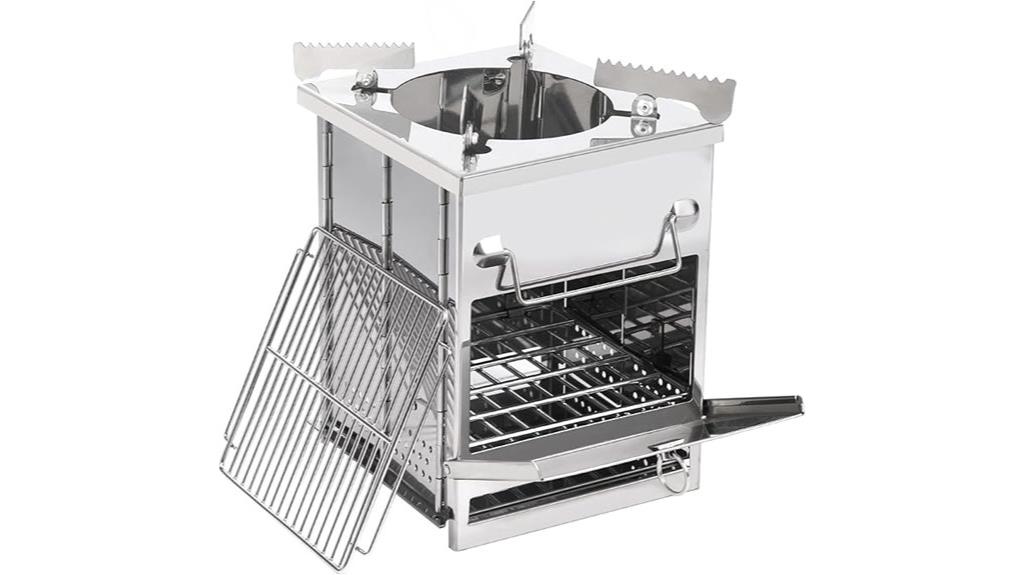
REDCAMP’s Wood Burning Folding Camp Stove delivers exceptional portability for backpackers who prioritize lightweight gear without sacrificing cooking performance. At 6.4 pounds, this stainless steel unit compresses from 7.9″x7.9″x10.2″ to a tablet-sized 10.6″x8.7″x2.4″ package. You’ll appreciate its multi-fuel capability—wood, charcoal, alcohol burners, and natural debris all work effectively. The high-grade stainless steel construction guarantees durability while remaining easy to clean after extended use. Quick assembly makes setup effortless in various conditions. With 4.5 stars from 563 users, you’re getting proven performance. However, the pot holders show some weakness compared to the robust grill functionality for direct cooking applications.
Best For: Backpackers and outdoor enthusiasts who need a lightweight, versatile cooking solution that can burn multiple fuel types including wood and natural debris.
Pros:
- Excellent portability with tablet-sized folding design and included carrying bag
- Multi-fuel capability works with wood, charcoal, alcohol burners, and natural materials
- Durable stainless steel construction that’s easy to clean and quick to assemble
Cons:
- At 6.4 pounds, it’s heavier than ultralight alternatives for serious backpackers
- Pot holders are reportedly flimsy and less reliable than the grill function
- Larger folded dimensions may not fit in compact backpacking setups
Gas One Camping Stove – Portable Wood Burning Stove with Grill Grid

Compact design meets exceptional versatility in the Gas One Camping Stove, making it an ideal choice for backpackers who prioritize lightweight gear without sacrificing cooking flexibility. At just 16 ounces and measuring 5.3″ x 5.3″ x 6.3″, this stainless steel stove burns wood, alcohol, or charcoal effectively.
The stove’s windproof serrated cross stand provides stability for cookware while maintaining optimal airflow. You’ll appreciate the interchangeable grill grate and pot stand ring, which adapt to various cooking needs. The stainless steel construction resists high heat and heavy loads reliably.
You can fuel this stove with twigs, branches, leaves, or wood pellets found naturally. Use seasoned materials to minimize initial smoke production. The included mesh storage bag simplifies transport and packing for extended backpacking trips.
Best For: Backpackers and outdoor enthusiasts who need a lightweight, versatile camping stove that can burn natural materials like wood and twigs while providing reliable cooking performance for small meals.
Pros:
- Ultra-lightweight at just 16 ounces with compact 5.3″ x 5.3″ x 6.3″ dimensions, perfect for backpacking
- Burns multiple fuel types including wood, alcohol, and charcoal with unlimited natural fuel sources available outdoors
- Durable stainless steel construction with windproof design and interchangeable grill grate and pot stand for cooking versatility
Cons:
- May produce initial smoke when using raw materials, requiring seasoned wood for optimal performance
- Small cooking capacity makes it suitable only for couple-sized meals, not larger groups
- Embers can fall through air holes, requiring use only on non-flammable surfaces for safety
GasOne Premium Wood Burning Rocket Stove for Camping & Survival
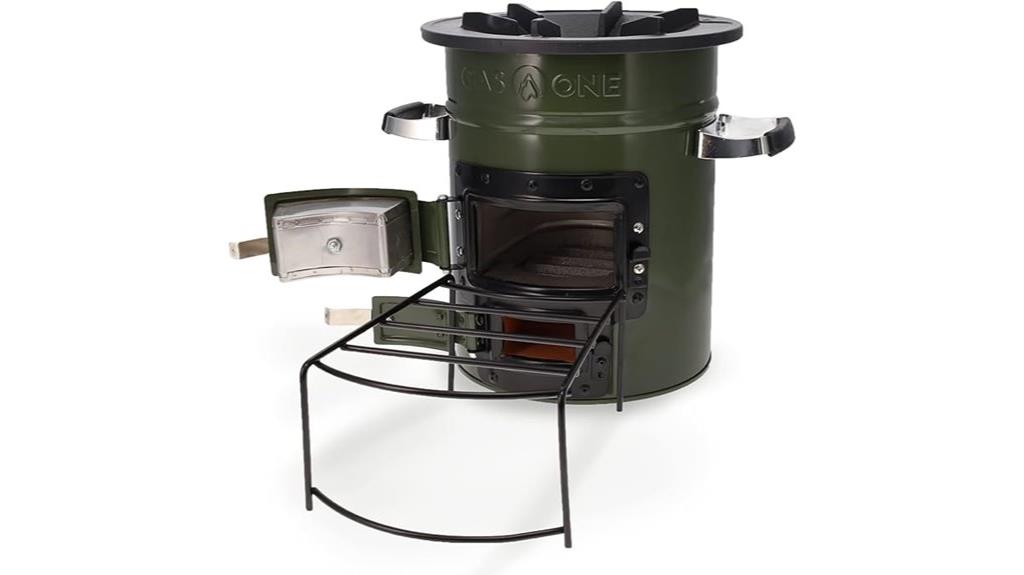
At 17.46 pounds, the GasOne Premium Wood Burning Rocket Stove transforms into a cooking powerhouse that serious outdoor enthusiasts will appreciate for extended base camp operations and emergency preparedness scenarios. You’ll find its 10.25L x 10.25W x 14H dimensions create a stable cooking platform. The heavy-duty metal and cast iron construction delivers exceptional durability for repeated field use.
This rocket stove design maximizes combustion efficiency through its insulated chamber system. You can burn wood, charcoal, or biomass fuels with minimal supervision. The built-in silicone handles enable safe transport even when hot. Temperature control becomes manageable through the sturdy design’s heat management capabilities. Users report efficient fuel consumption and quick heating times that maintain consistent high output for various cooking techniques.
Best For: Serious outdoor enthusiasts, campers, and survivalists who need a durable, efficient wood-burning cooking solution for extended base camp operations and emergency preparedness scenarios.
Pros:
- Exceptional combustion efficiency with insulated rocket stove design that burns multiple fuel types (wood, charcoal, biomass) with minimal supervision
- Heavy-duty metal and cast iron construction provides superior durability for repeated field use with built-in silicone handles for safe transport
- Quick heating times with consistent high output and manageable temperature control for various cooking techniques
Cons:
- At 17.46 pounds, it’s significantly heavier than lightweight camping stoves, making it less suitable for backpacking or hiking
- Initial issues reported with paint flaking and door fitting that may require adjustments
- Requires hardwood with low resin content for optimal performance and minimal smoke production
Factors to Consider When Choosing a Wood Burning Backpacking Stove
When I’m selecting a wood burning backpacking stove, I evaluate five critical factors that determine performance in the backcountry. Weight becomes paramount since every ounce matters during multi-day treks, while material construction affects both durability and heat distribution efficiency. I also consider fuel compatibility, assembly complexity, and cooking performance to guarantee the stove meets my specific outdoor cooking requirements.
Weight and Portability
Breaking down the essentials of backpacking gear selection, weight and portability stand as the primary deciding factors for wood burning stoves. I’ve found that top models range from 0.98 to 7 pounds, with ultralight options targeting serious backpackers. The collapsible design matters greatly—quality stoves compress to approximately 0.2 inches thick, fitting easily into pack compartments.
You’ll appreciate that wood burning stoves eliminate fuel canister weight entirely. Instead of carrying heavy propane or butane, you’ll gather twigs and branches at your campsite. Most manufacturers include carrying bags for streamlined transport and protection.
Quick assembly becomes vital when you’re tired after long hiking days. I recommend stoves with intuitive folding mechanisms that don’t require tools or complex setup procedures, ensuring reliable performance without compromising your pack’s weight distribution.
Material and Durability
While weight matters greatly in backpacking gear, the material composition of your wood burning stove determines whether it’ll survive countless wilderness adventures or fail when you need it most. I recommend stainless steel and titanium as top choices for their exceptional rust and corrosion resistance.
Grade-1 titanium offers the best strength-to-weight ratio while maintaining structural integrity under extreme conditions. High-quality stainless steel provides excellent durability at a lower cost. Both materials resist warping under heat stress and support heavy cookware without deformation.
Look for stoves featuring heavy-duty seams, reinforced edges, and high-temperature resistance ratings. These design elements notably extend operational lifespan during intensive use. Robust construction guarantees your stove performs reliably on extended trips where equipment failure isn’t an option.
Fuel Compatibility Options
Understanding fuel compatibility options expands your stove’s versatility across different environments and weather conditions. I recommend choosing models that burn natural materials like twigs, leaves, and branches—these fuels are typically abundant in most outdoor environments. Many quality stoves accommodate both biomass and traditional solid fuel tablets, giving you backup options when natural materials aren’t available.
Look for stoves with efficient gasification systems. These designs can burn semi-wet wood once they reach operating temperature, which proves invaluable during unexpected weather changes. You’ll achieve excellent performance using dry, seasoned twigs that ignite quickly and produce minimal smoke.
Consider models offering multi-fuel capability. Some accept charcoal or alcohol as alternatives, expanding utility for emergency situations or environments with limited natural fuel sources.
Assembly and Setup
Once you’ve selected a stove with the right fuel compatibility, assembly speed becomes your next priority in the field. Most quality wood burning backpacking stoves achieve setup in under 30 seconds without tools. I look for collapsible designs that fold flat for transport while maintaining structural integrity when assembled.
Buckle systems and interlocking parts offer the most reliable assembly methods. These mechanisms eliminate loose components that you might drop in low-light conditions. Clear instruction cards should accompany your stove, though intuitive designs require minimal reference.
Base stability determines cooking safety on uneven terrain. Wide-footprint models provide superior stability but increase pack weight. I prioritize stoves with adjustable legs or level indicators for rocky campsites. Proper base contact prevents tipping incidents that waste fuel and create fire hazards.
Cooking Efficiency Performance
When selecting a wood burning stove, cooking efficiency directly impacts your backcountry meal preparation timeline and fuel consumption rates. I evaluate performance through water boiling speed, with quality models achieving 10-15 minute boil times depending on pot size and fuel type. Gasification design proves critical for sustained heat output. Efficient stoves maintain cooking temperatures for 30-40 minutes without reloading fuel. Natural fuel versatility matters considerably. You’ll find twigs, branches, and leaves provide reliable heat sources, eliminating heavy canister dependency. Air vent positioning affects combustion efficiency and heat distribution patterns. I prioritize stoves supporting multiple cookware sizes while maintaining quick setup capabilities. Heat retention features directly correlate with consistent cooking temperatures throughout meal preparation.
Size and Capacity
Beyond cooking performance, the physical dimensions and capacity of your wood burning stove determine its practical viability for backpacking applications. Stove sizes range dramatically from compact 4.9 x 4.9 x 6.3 inch models to larger 11.8 x 11.8 x 18.5 inch units. Weight variations span from 11.3 ounces to over 17 pounds, directly affecting your pack load.
I recommend evaluating your group size first. Smaller stoves suit one or two people, while larger models accommodate bigger cookware for group cooking. The combustion chamber capacity determines burn duration—quality stoves provide 40-60 minutes of burn time per wood load. Consider collapsed dimensions carefully since efficient packing matters on multi-day trips. Larger capacity means longer cooking sessions but compromises portability.
On a final note
I’ve analyzed the top-performing wood burning backpacking stoves based on weight, burn efficiency, and construction materials. Each model offers distinct advantages for different hiking scenarios. The Kuvik Titanium provides ultralight performance at 5.3 ounces, while the REDCAMP delivers robust functionality with its steel construction. Your choice depends on pack weight priorities, cooking needs, and budget constraints. These stoves eliminate fuel dependency and reduce environmental impact during extended backcountry adventures.

